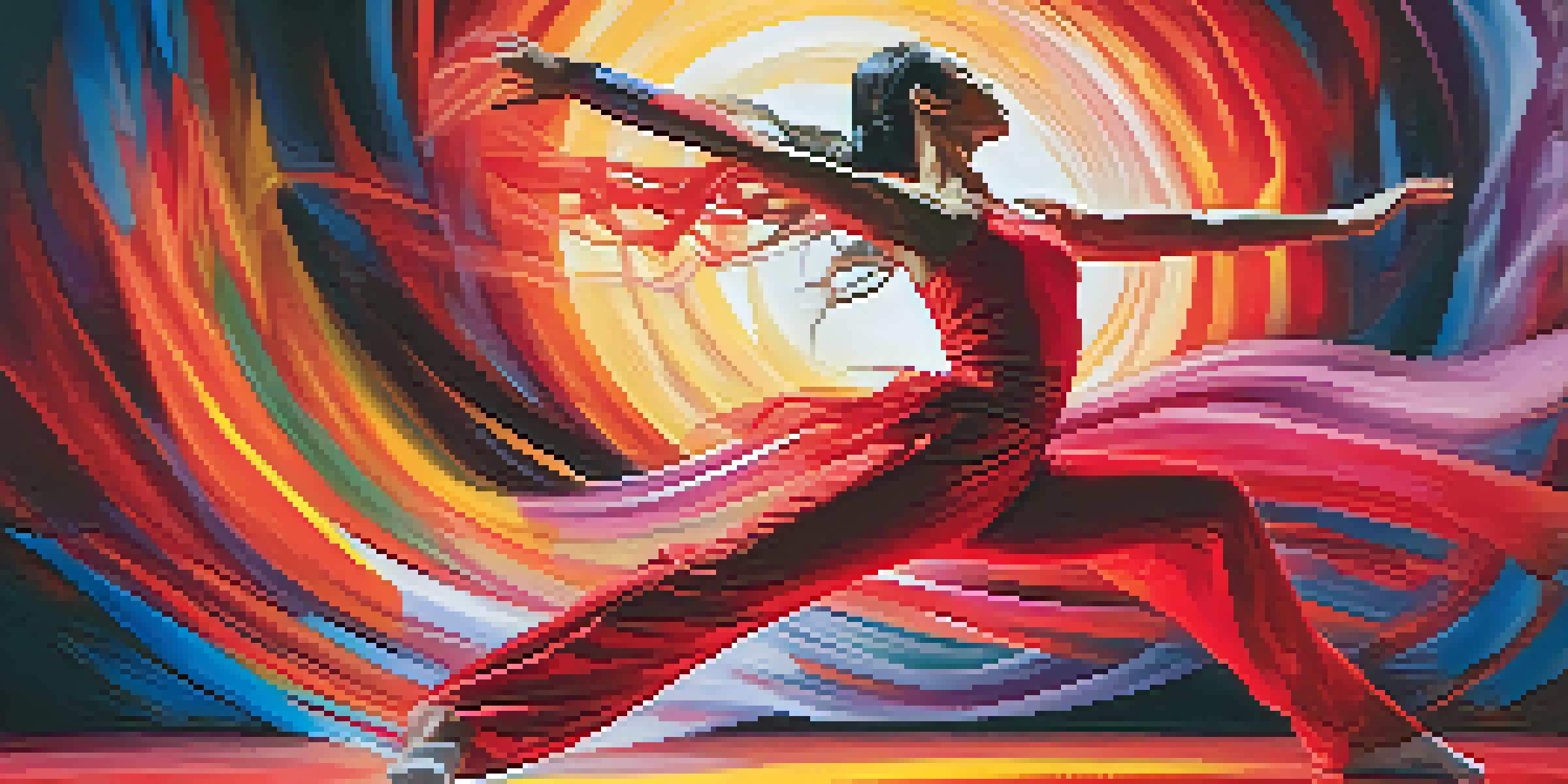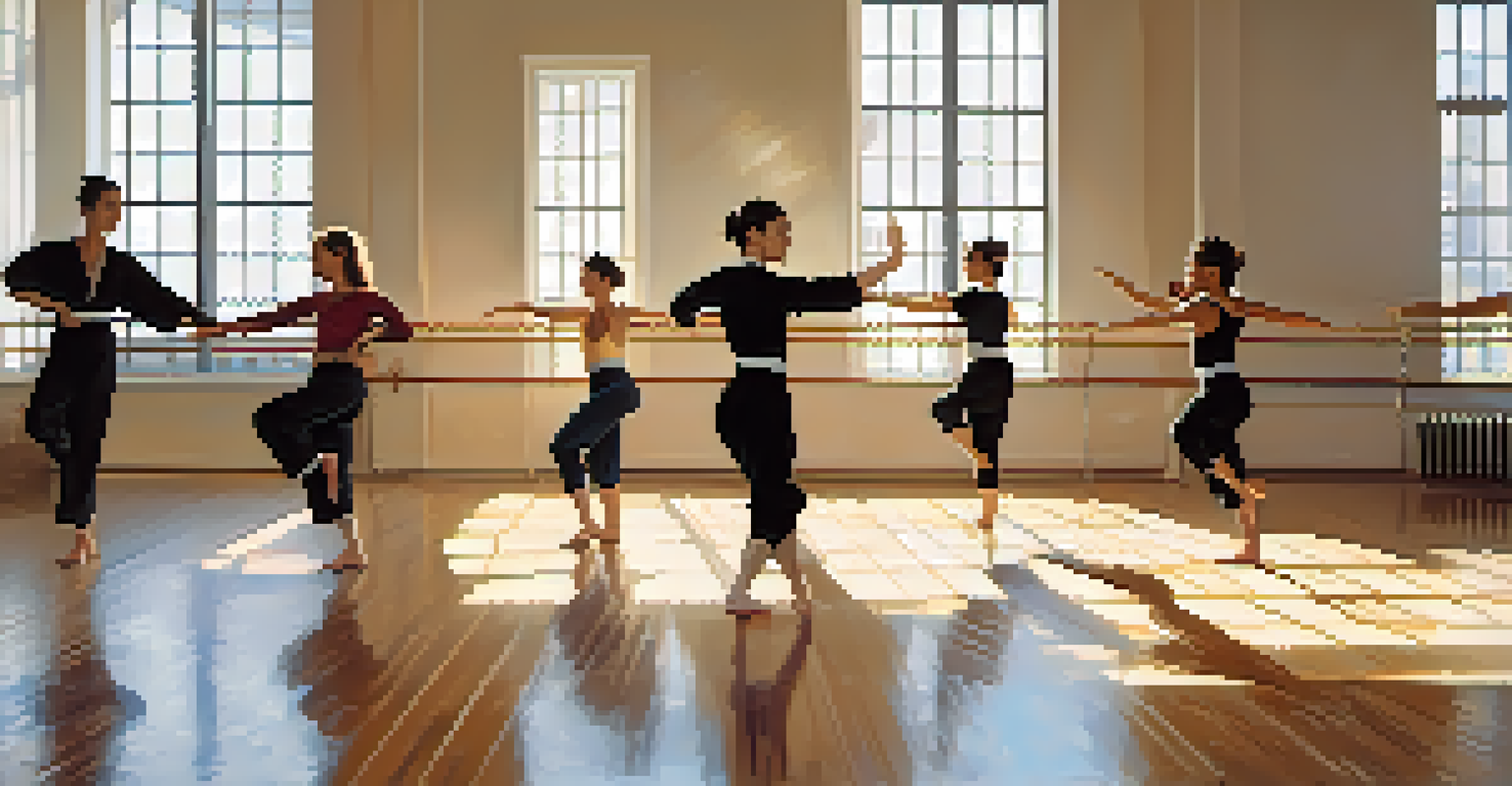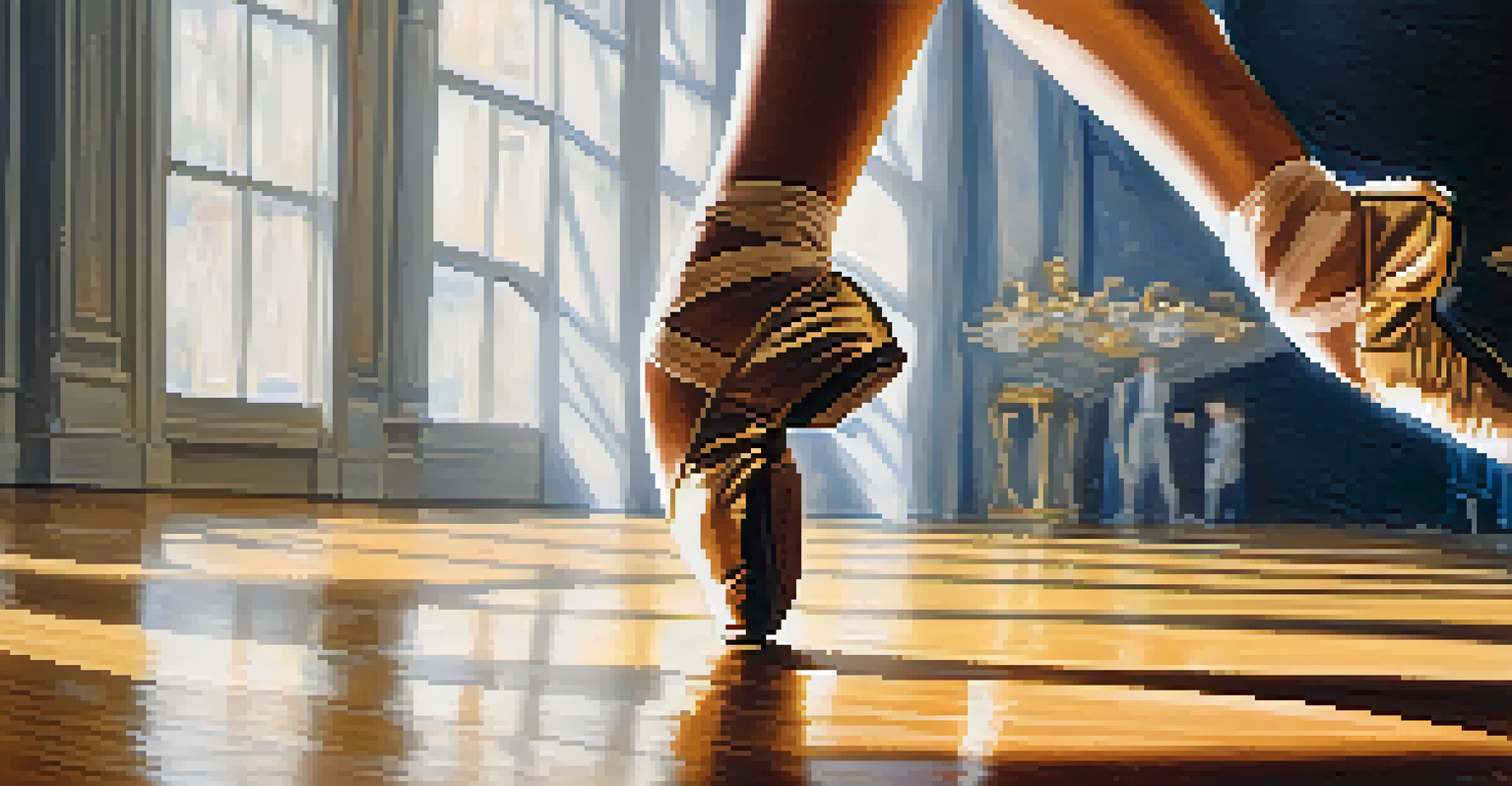Choreographic Innovations Inspired by Martial Arts Movements

The Fusion of Dance and Martial Arts: A Brief Overview
Choreography has long been influenced by various physical disciplines, and martial arts is no exception. The fluidity and precision found in martial arts offer a unique vocabulary for dancers to explore. By incorporating these movements, choreographers can create dynamic pieces that captivate audiences and highlight the strength of both art forms.
Dance is the hidden language of the soul.
Many choreographers have found inspiration in the structured techniques of martial arts, such as Taekwondo and Kung Fu. These practices emphasize not just physicality, but also mental focus and discipline, making them a rich source for artistic expression. Dancers who study these forms often find a deeper connection to their own bodies and movements, leading to innovative choreography.
The interplay between martial arts and dance creates a fascinating dialogue, allowing artists to explore themes of conflict, resolution, and harmony. This fusion not only enriches the performance but also expands the narrative possibilities within choreography, offering fresh perspectives on traditional storytelling.
Notable Choreographers Embracing Martial Arts Techniques
Several choreographers have successfully integrated martial arts into their work, each bringing their unique vision to the stage. For example, renowned choreographer Martha Graham incorporated elements of Japanese Noh and martial arts into her modern dance pieces, creating a powerful blend of strength and grace. This approach encourages dancers to push their physical limits while exploring emotional depth.

Similarly, the works of choreographer Akram Khan reflect a seamless integration of South Asian dance forms and martial arts. His choreography often features striking movements reminiscent of combat, yet they are used to convey vulnerability and human connection. This juxtaposition creates a captivating visual experience that resonates with audiences.
Dance Meets Martial Arts Techniques
Choreographers are increasingly integrating martial arts movements into dance, enhancing artistic expression and performance dynamics.
Additionally, the innovative styles of choreographer Wayne McGregor showcase the athleticism of martial arts within contemporary dance. His pieces often include sharp, rapid movements that echo martial techniques, demonstrating how these influences can lead to a new, exciting language of movement.
Understanding the Physicality of Martial Arts in Dance
At its core, dance is about movement, and martial arts excel in teaching the body how to move efficiently and powerfully. The principles of balance, strength, and agility found in martial arts can greatly enhance a dancer's technique. This physicality not only improves performance quality but also fosters a greater awareness of the body’s capabilities.
Martial arts are not about fighting; they are about building character.
For instance, the practice of Tai Chi emphasizes slow, controlled movements, which can help dancers develop a sense of grounding and flow. The principles of this gentle martial art can translate into dance, allowing performers to explore dynamics and transitions with more finesse. By adopting these techniques, dancers can create a richer visual experience that engages the audience on multiple levels.
Moreover, the explosive energy of martial arts techniques, such as kicks and spins, can be incorporated into choreography to heighten dramatic moments. This approach challenges dancers to expand their movement vocabulary and express intense emotions through physicality, resulting in performances that are both visually striking and emotionally resonant.
Cultural Significance of Martial Arts in Dance
The integration of martial arts into dance is not only about movement; it also celebrates cultural heritage. Many martial arts have deep-rooted histories and philosophies that can enrich a dance narrative. By incorporating these elements, choreographers pay homage to the origins of these practices and create a more profound connection with the audience.
For example, Capoeira, a Brazilian martial art that combines elements of dance, has inspired countless choreographers to explore themes of community and resilience. The rhythmic movements and cultural significance of Capoeira can transform a performance into a celebration of identity and heritage. This cultural layering adds depth to the choreography, making it more relatable and impactful.
Cultural Depth in Choreography
Incorporating martial arts not only enriches the narrative of dance but also celebrates the cultural heritage behind these practices.
By weaving the cultural narratives of martial arts into dance, choreographers can address larger social issues, such as conflict, peace, and understanding. This fusion invites audiences to reflect on their own experiences while appreciating the beauty of diverse traditions, creating a more inclusive art form.
Enhancing Performance through Martial Arts Training
For dancers, training in martial arts can offer a multitude of benefits, from improved strength to enhanced flexibility. Many dancers find that martial arts training helps them develop a sense of discipline and focus that translates into their dance practice. This cross-disciplinary approach not only enhances their physical abilities but also fosters a greater appreciation for the art of movement.
Moreover, martial arts training can help dancers learn how to control their bodies in new ways. The emphasis on precision and technique in martial arts allows dancers to refine their skills, making their performances more impactful. This additional training can also lead to increased confidence, as dancers become more aware of their physical capabilities and limitations.
Additionally, the mental aspect of martial arts, which includes meditation and mindfulness, can greatly benefit dancers. By incorporating these practices into their routines, dancers can cultivate a greater sense of presence and awareness on stage, leading to more authentic performances that resonate with audiences.
Audience Engagement: The Impact of Martial Arts in Dance
Incorporating martial arts movements into dance can significantly enhance audience engagement. The dynamic nature of martial arts often captivates viewers, drawing them into the performance. This engagement creates a shared experience, allowing the audience to feel the intensity of the movements and the emotions being conveyed.
Choreographers who blend these two art forms create a spectacle that can evoke a wide range of reactions, from awe to inspiration. By showcasing the physicality and discipline of martial arts, dancers can push the boundaries of traditional dance, offering something fresh and exciting for audiences to experience. This innovative approach can attract new audiences, expanding the reach of both art forms.
Audience Engagement Through Fusion
The blend of martial arts in dance captivates audiences, creating a visceral experience that enhances emotional storytelling.
Furthermore, martial arts-inspired choreography can serve as a powerful storytelling tool. The sharp movements and dramatic poses can convey conflict and resolution, engaging the audience’s emotions in a unique way. This ability to tell a story through physical expression enhances the overall impact of the performance and leaves a lasting impression.
Future Directions: The Evolution of Choreography
As the world of dance continues to evolve, the integration of martial arts movements is likely to expand further. Choreographers are increasingly exploring how these two disciplines can inform and inspire each other, leading to innovative works that push traditional boundaries. This evolution reflects a broader trend in the arts, where cross-disciplinary collaboration is becoming more common.
Emerging technologies, such as motion capture and virtual reality, could also play a role in the future of choreography influenced by martial arts. These tools allow for new ways of exploring movement and can provide exciting avenues for creative expression. As artists experiment with these technologies, we may see even more dynamic and immersive performances that challenge our understanding of both dance and martial arts.

Ultimately, the fusion of martial arts and choreography not only enriches the dance landscape but also opens doors for ongoing exploration and creativity. As we look to the future, we can expect to see an exciting blend of physicality and artistry that continues to engage and inspire audiences around the world.